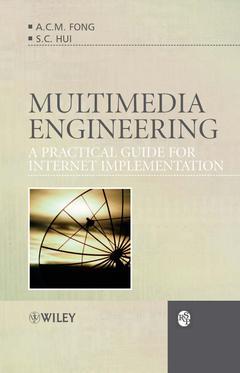Multimedia Engineering A Practical Guide for Internet Implementation RSP Series
Auteurs : Fong A. C. M., Hui S. C., Hong Guanyue, Fong Bernard

- Provides an overview of state-of-the-art technologies
- Addresses commerical, industrial and educational applications and security and privacy issues.
- Offers a detailed background into how the internet has been used to support multimedia communications
- Assumes a practical and descriptive problem-solving approach, featuring many worked-through examples
- Written by widely published authors with years of research in the field
Multimedia Engineering will appeal to graduate and senior undergraduate students in electrical and electronic engineering, industrial, systems & computer engineering. It will also be of interest to electrical, computer and systems engineers and web developers interested in, or already engaged in, this emerging field.
1. The Information Age and this Book.
2. The internet, World Wide Web and Multimedia.
2.1 The Internet.
2.2 The World Wide Web.
2.3 Multimedia.
3. Organization
Chapter 3. The Internet As An Information Repository.
1. Introduction
2. Current Status, Promises and Challenges.
3. Search Engines
3.1 Indexing 13
3.2 Retrieval
3.3 Meta Search Engines
3.4 Non-Technical Limitations of Search Engine
4. Personalized Monitoring Services
Current Web Monitoring Systems
4.2 An Alternative Web Monitoring Model
4.3 The Web Information Monitoring System (WIM)
5. Storage and Retrieval of Visual Data.
5.1 Images
5.2 Videos
6. Case Study: Discovery/Monitoring of Web Publications.
6.1 Discovery of Web Scientific Publications
6.2 Monitoring of Scientific Publications
7. Further Advancements.
7.1 Semantic Web
7.2 Human-Centric Query Processing
7.3 Intelligent Agents
Chapter 3. The Internet As A Communications Medium.
1. Introduction
2. Internet Communication Protocols
2.1 Transmission Control Protocol (TCP)
2.2 User Datagram Protocol (UDP)
2.3 Real-time Transport Protocol (RTP)
2.4 Hypertext Transport Protocol (HTTP)
2.5 Real-Time Streaming Protocol (RTSP)
2.6 Illustration
3. Electronic Mail
3.1 Email Protocols
3.2 Email Systems
4 Online Presence Notification and Instant Messaging.
4.1 Current Online Presence Notification Approaches
4.2 Instant Messaging Systems
4.3 The Online Presence Notification Protocol
4.4 Online Presence Notification System
5. Internet Telephony.
5.1 Overview of an Internet Telephony System
5.2 Using Java for Platform Independence
5.3 Internet Java Phone
5.4 Performance Comparison
6. Video Data Transmission.
6.1 Video Streaming
6.2 Quality of Service Issues
6.3 Application-layer QoS Control
6.4 Adaptive Transmission and Recovery Mechanism
7.; Desktop Videoconferencing
7.1 The ITU H.3xx Standards
7.2 Session Initiation Protocol (SIP)
8. Unified Messaging.
8.1 Personal Communicator
8.2 Real-Time Communication Services
Chapter 4. Internet Security.
1. Introduction
2. Internet Security ¾ An Overview
2.1 Web Server Related Security
2.2 Software Security
3 Practical Approaches.
3.1 Access Security
3.2 Transfer Security
3.3 Cryptography
3.4 Commercial Solutions
4 Security for Java ¾ An Internet Java Phone Example.
4.1 Java Security Architecture
4.2 Applet Security Restrictions
4.3 Overcoming Security Restrictions
5 Biometrics for Identity Authentication Multi-view Facial Analysis.
5.1 The Need for an Effective Distance Measure
5.2 The Significance-Based Multi-View Hausdorff Distance
5.3 An Experimental System
5.4 System Performance
Chapter 5. Internet Privacy.
1. Introduction
2 Web Content Filtering Methods and Tools A Survey
2.1 Current Methods
2.2 Current Systems Performance Analysis
3 An Effective Web Content Filtering System
3.1 Analysis of the Target Web Pages
3.2 System Implementation
3.3 Performance Analysis
Chapter 6. Commercial And Industrial Applications.
1. Introduction
2. Virtual Electronic Trading For B2b E-Commerce.
2.1 Survey of b2b E-commerce Systems
2.2 The VET system
3. Web-based Customer Technical Support
3.1 Customer Service Database
3.2 Data mining for Machine Fault Diagnosis
3.3 Machine Fault Diagnosis over the WWW
3.4 Performance Evaluation
4. Knowledge Discovery for Managerial Decisions
4.1 Seven-Step Process for Knowledge Discovery
4.2 Establish Mining Goals
4.3 Select Data
4.4 Preprocess Data
4.5 Transform Data
4.6 Store Data
4.7 Mine Data
4.8 Evaluate Mining Results
5. Web-based Intelligent Surveillance System
5.1 Design Objectives and Related Systems
5.2 System Overview and Major Components
5.3 Monitoring Process
5.4 Technical Challenges and Solutions
Chapter 7. (by G. Y. Hong) Implementing and Delivering Internet and Multimedia Projects.
1. Introduction
2. Process Modeling and Lifecycle
2.1 Waterfall Model
2.2 Spiral Model
2.3 Prototyping Model
2.4 Incremental and Iterative Development
3. Project Planning and Management
3.1 Identify Your Business Objectives and Target Audience
3.2 Analyse the Requirements and Build Domain Knowledge
3.3 Document Your Project Plan
3.4 Build the Development Team
3.5 Review Your Current Standards and Procedures
3.6 Identify Project Sponsors and Business Partners
3.7 Adopt Just-in-Time Training Approach
3.8 Track the Progress
3.9 Sales and Marketing
4. Design, Implementation and Testing.
4.1 Designing User Interface
4.2 Designing the Database
4.3 Getting User Feedback
4.4 Security
4.5 Reliability Growth Testing
4.6 Enabling Tools and Technologies
5. Measurements
5.1 Identifying Metrics: Goal Question Measurement (GQM) Approach
5.2 Software Metrics
5.3 Continuous Improvement
6. Conclusion
Chapter 8. (by B. Fong) From E-Commerce to M-Commerce.
1. Electronic Commerce.
2. Going Mobile
3. Marketing and Mobility.
4. Providing Reliable M-commerce Service is Challenging.
4.1 Security
4.2 Reliability
4.3 Effects of Rain
4.4 Modulation Schemes
5 Chapter Summary.
Appendix A.
Popular Colour Models.
Appendix B.
Glossary.
Index.
S. C. Hui is an associate professor in the School of Computer Engineering, Nanyang Technological University, Singapore. He received his D. Phil in 1987 from the University of Sussex, UK. He worked in IBM China/Hong Kong Corporation as a system engineer from 1987 to 1990. His current research interests include data mining, Web mining, Semantic Web, intelligent systems, information retrieval, timetabling and scheduling.
Date de parution : 06-2006
Ouvrage de 286 p.
15.8x23.5 cm
Mots-clés :
lives; intrinsic; daily; internet; way; future; advances; latest; multimedia; technology; engineering; practical; development; reader; many; range; insight; problems; broad coverage; transmission; applications; technologies



